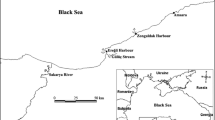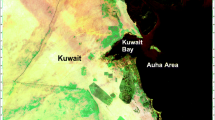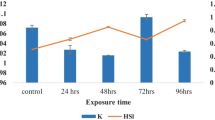Abstract
The present study reports the first analysis of water pollutants in Sri Lankan waters using a suite of biomarkers in Nile tilapia (Oreochromis niloticus) residing in Bolgoda Lake which receives urban, industrial and domestic wastes from multiple sources. The fish were collected from the lake in the dry period (April 2005) and wet periods (September 2005, October 2006) and the levels of biomarkers viz. hepatic ethoxyresorufin O-deethylase (EROD), glutathione S-transferase (GST), metallothioneins, biliary fluorescent aromatic compounds, brain and muscle cholinesterases (ChE) were compared with those of the laboratory reared control fish and the fish obtained from a less polluted water body, Bathalagoda reservoir (reference site). The results revealed that biomarker levels of the fish collected from the reference site were not significantly different from the controls. Hepatic EROD and GST activities in fish from Bolgoda Lake were induced 4.2–16.6 folds and 1.4–3.3 folds respectively compared with the control fish. Analysis of bile in the lake fish revealed recent uptake of naphthalene, pyrene and benzo(a)pyrene type polycyclic aromatic hydrocarbons (PAHs). The induction of EROD activities in feral fish reflects the exposure of fish to aryl hydrocarbon receptor agonists including PAHs present as pollutants in the Bolgoda Lake. Cholinesterase activity in the fish inhabiting one sampling site of Bolgoda Lake was lower (22–40% inhibition) than the activity measured in the control fish indicating the presence of anticholinesterase pollutants in the area. Hepatic metallothionein levels in the lake fish were higher (1.9–3.2 folds) in comparison to the controls indicating metal exposure. The results support the potential use of these biomarkers in Nile tilapia in assessing pollution in tropical water bodies.
Similar content being viewed by others
References
Aas, E., Beyer, J., & Goksoyr, A. (2000). Fixed wavelength fluorescence (FF) of bile as a monitoring tool for polyaromatic hydrocarbon exposure in fish: An evaluation of compound specificity, inner filter effect and signal interpretation. Biomarkers, 5(1), 9–23. doi:10.1080/135475000230505.
Cook, J. M., Garder, M. J., Griffith, A. H., Jessep, M. A., Ravenscroft, J. E., Yates, R. (1997). The comparability of sample digestion techniques for the determination of metals in sediments. Marine Pollution Bulletin, 34(8), 37–644. doi:10.1016/S0025-326X(96)00186-5.
Ellman, G. L., Coutney, K. D., Anders Jr. V., & Featherstone, R. M. (1961). A new and rapid colourimetric determination of acetylcholinesterase activity. Biochemical Pharmacology, 7, 85–95. doi:10.1016/0006-2952(61)90145-9.
Fulton, M. H., & Key, P. B. (2001). Acetylcholinesterase inhibition in estuarine fish and invertebrates and indicator of organophosphorus insecticide exposure and effects. Environmental Toxicology and Chemistry, 20, 37–45. doi:10.1897/1551-5028(2001)020<0037:AIIEFA>2.0.CO;2.
George, S. G. (1994). Enzymology and molecular biology of phase II xenobiotic conjugating enzymes in fish. In D. C. Malins, & G. K. Ostrander (Eds.), Aquatic toxicology: Molecular, biochemical and cellular perspective (pp. 37–85). Boca Raton, FL: Lewis.
Gold-Bouchot, G., Zapta-Perez, O., Rodriguez-Fuentes, G., Ceja-Moreno, V., Rio-Garcia, M. D., & Chzan-Cocom, E. (2006). Biomarkers and pollutants in the Nile tilapia, Oreochromis niloticus, in four lakes from San Miguel, Chiapa, Mexico. International Journal of Environmental Pollution, 26(1/2/3), 130–141.
Habig, W. H., Pabst, M. J., & Jakoby, W. B. (1974). Glutathione S-transferases. The first enzymatic step in mercapturic acid formation. The Journal of Biological Chemistry, 249, 7130–7139.
Klotz, A. V., Stegeman, J. J., & Walsh, C. (1984). An alternative 7-ethoxyresorufin O-deethylase activity assay; a continuous visible spectrometric method for measurement of cytochrome P-450 monooxygenase activity. Analytical Biochemistry, 140, 138–145. doi:10.1016/0003-2697(84)90144-1.
Livingstone, D. R., & Goldfarb, P. S. (1998). Biomonitoring in the aquatic environment: Use of cytochrome P 4501A and other molecular biomarkers in fish and mussels. In J. M. Lynch, & A. Wiseman (Eds.), Environmental biomonitoring. the biotechnology, ecotoxicology interface (pp. 101–129). Cambridge: Cambridge University Press.
Lowry, H., Rosebrough, N. J., Farr, A. L., & Randall, R. J. (1951). Protein measurement with the Folin phenol reagent. The Journal of Biological Chemistry, 193, 265–275.
Napierska, D., Kopecka, J., Podolska, M., & Pempkowiak, J. (2006). Hepatic glutathione S-transferase activity in flounder collected from contaminated and reference sites along the Polish Coast. Ecotoxicology and Environmental Safety, 65, 355–363. doi:10.1016/j.ecoenv.2005.07.022.
Olafson, R. W., & Olsson, P. (1991). Electrochemical detection of metallothionein. Methods in Enzymology, 205, 205–213. doi:10.1016/0076-6879(91)05100-A.
Pathiratne, A., Chandrasekara, L. W. H. U., & De Seram, P. K. C. (2008). Effects of biological and technical factors on brain and muscle cholinesterases in Nile tilapia, Oreochromis niloticus: Implications for biomonitoring neurotoxic contaminations. Archives of Environmental Contamination and Toxicology, 54, 309–317. doi:10.1007/s00244-007-9025-1
Pathiratne, K. A. S., De Silva, O. C. P., Hehemann, D., Atkinson, I., & Wei, R. (2007). Occurrence and distribution of polycyclic aromatic hydrocarbons (PAHs) in Bolgoda and Beira Lakes, Sri Lanka. Bulletin of Environmental Contamination and Toxicology, 79(2), 135–140.
Payne, J. F., Mathieu, A., Melvin, W., & Fancey, L. L. (1996). Acetylcholinesterase, an old biomarker with a new future? Field trials in association with two urban rivers and a paper mill in New Foundland. Marine Pollution Bulletin, 32, 225–231. doi:10.1016/0025-326X(95)00112-Z.
Peakall, D. W. (1994). Biomarkers: The way forward in environmental assessment. Toxicology and Ecotoxicology News, 1, 55–60.
Roesijadi, G., & Robinson, W. E. R. (1994). Metal regulation in aquatic animals: Mechanisms of uptake, accumulation and release. In D. C. Malins, & G. K. Ostrande (Eds.), Aquatic toxicology: Molecular, biochemical and cellular perspectives (pp. 387–420). Boca Raton, FL: Lewis.
Senarathne, P., & Pathiratne, K. A. S. (2007). Accumulation of heavy metals in a food fish Mystus gulio inhabiting Bolgoda Lake, Sri Lanka. Sri Lanka Journal of Aquatic Sciences, 12, 61–76.
Silva, E. I. L. (1996). Water quality in Sri Lanka—a review on twelve waterbodies. Kandy, Sri Lanka: Institute of Fundamental Studies.
Van der Oost, R., Beyer, J., & Vermeulan, N. P. E. (2003). Fish bioaccumulation and biomarkers in environmental risk assessment: A review. Environmental Toxicology and Pharmacology, 13, 57–149. doi:10.1016/S1382-6689(02)00126-6.
Wellala, W. D. G. S. C. (2005). Status of the fishery of Bathalagoda reservoir, Sri Lanka. M.Sc. Dissertation, University of Kelaniya, Sri Lanka.
Whyte, J. J., Jung, R. E., Schmitt, C. J., & Tillitt, D. E. (2000). Ethoxyresorufin-O-deethylase (EROD) activity in fish as a biomarker of chemical exposure. Critical Reviews in Toxicology, 30, 347–570. doi:10.1080/10408440091159239.
Wijeyaratne, W. M. D. N., & Pathiratne, A. (2006). Acetylcholinesterase inhibition and gill lesions in Rasbora caverii an indigenous fish inhabiting rice field associated waterbodies in Sri Lanka. Ecotoxicology (London, England), 15, 609–619. doi:10.1007/s10646-006-0101-5.
Zar, J. H. (1999). Biostatistical analysis. Upper Saddle River, NJ: Prentice Hall.
Zinkl, J. G., Lockhart, W. L., Kenny, S. A., & Ward, F. J. (1991). The effects of cholinesterase-inhibiting chemicals on fish. In: P. Mineau (Ed.), Cholinesterse-inhibiting insecticides. Chemicals in agriculture (Vol. 2, pp. 151–172). Amsterdam: Elsevier.
Author information
Authors and Affiliations
Corresponding author
Rights and permissions
About this article
Cite this article
Pathiratne, A., Chandrasekera, L.W.H.U. & Pathiratne, K.A.S. Use of biomarkers in Nile tilapia (Oreochromis niloticus) to assess the impacts of pollution in Bolgoda Lake, an urban water body in Sri Lanka. Environ Monit Assess 156, 361–375 (2009). https://doi.org/10.1007/s10661-008-0490-4
Received:
Accepted:
Published:
Issue Date:
DOI: https://doi.org/10.1007/s10661-008-0490-4




